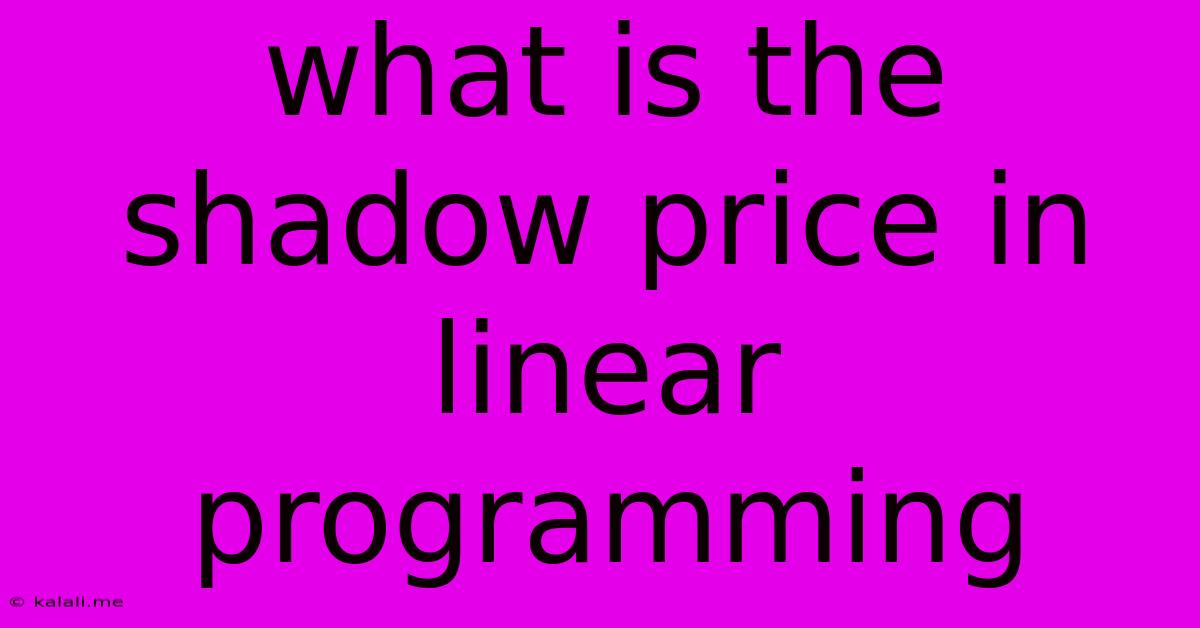What Is The Shadow Price In Linear Programming
Kalali
Jun 03, 2025 · 3 min read

Table of Contents
What is the Shadow Price in Linear Programming? Unlocking the Value of Constraints
Linear programming (LP) is a powerful mathematical technique used to optimize a given objective function subject to various constraints. Understanding the intricacies of LP can significantly improve decision-making in various fields, from operations research and supply chain management to finance and resource allocation. A crucial concept within LP is the shadow price, also known as the dual value or marginal value. This article will demystify the shadow price, explaining its meaning, calculation, and practical applications.
What exactly is a shadow price? In simple terms, the shadow price represents the marginal increase in the objective function value resulting from a one-unit increase in the right-hand side (RHS) of a particular constraint, assuming all other factors remain constant. It essentially quantifies the value of relaxing a constraint—how much more optimal your solution could become if you had slightly more of a limited resource.
Think of it this way: if a constraint represents a limited resource (like budget, labor hours, or raw materials), the shadow price indicates how much extra profit (or other objective function value) you could gain by acquiring one more unit of that resource. If the shadow price is zero, it means that having more of that resource wouldn't improve your solution – it's already abundant enough.
Understanding the Context: Constraints and Optimality
Before diving deeper into shadow prices, it's important to grasp the fundamentals of linear programming constraints. These constraints define the feasible region – the set of all possible solutions that satisfy the problem's limitations. The optimal solution lies within this feasible region, maximizing (or minimizing) the objective function.
The shadow price is specifically associated with binding constraints. A binding constraint is one that is fully utilized at the optimal solution. In other words, the optimal solution lies directly on the constraint line; there's no slack. Non-binding constraints, on the other hand, have some slack, meaning the optimal solution doesn't fully use the available resources. Only binding constraints have non-zero shadow prices.
How are Shadow Prices Calculated?
Calculating shadow prices typically involves solving the dual linear program associated with the original primal LP problem. The dual LP provides valuable economic interpretations of the primal problem's solution. While the mathematical details are beyond the scope of this introductory explanation, most linear programming software packages (like Excel Solver or specialized optimization software) automatically calculate and report shadow prices alongside the optimal solution. They are usually displayed alongside the constraint information in the sensitivity report.
Interpreting and Using Shadow Prices
The interpretation of shadow prices is critical for informed decision-making. Here are some key takeaways:
- Positive Shadow Price: A positive shadow price indicates that increasing the constrained resource by one unit would improve the objective function value by that amount. This suggests that acquiring more of this resource is valuable and potentially worth the investment.
- Zero Shadow Price: A zero shadow price indicates that increasing the resource will not improve the objective function. The resource is already abundant, and there is no benefit in acquiring more.
- Range of Optimality: Associated with each shadow price is a range of optimality. This range specifies how much the RHS of the constraint can change without altering the shadow price. Within this range, the interpretation of the shadow price remains valid. Outside this range, the shadow price changes, reflecting the potential changes in the optimal solution and the objective function.
Practical Applications of Shadow Prices
Shadow prices find applications across diverse fields:
- Resource Allocation: Determining the optimal allocation of limited resources like budget, labor, or raw materials.
- Project Management: Evaluating the value of investing extra time or resources in specific project tasks.
- Pricing Strategies: Understanding the impact of production capacity constraints on product pricing.
- Supply Chain Optimization: Improving efficiency and reducing costs by optimizing inventory levels and logistics.
Understanding shadow prices allows decision-makers to evaluate the true value of constrained resources, enabling more informed and efficient resource allocation. It transforms simple optimization into actionable insights. By leveraging this crucial concept within linear programming, businesses can achieve enhanced efficiency and maximize their objective functions.
Latest Posts
Latest Posts
-
How To Say Orders Ship At Next Delivery Cycle
Jun 05, 2025
-
How Do You Repair A Leaking Shower Faucet
Jun 05, 2025
-
Ways To Display Skills Personal Website
Jun 05, 2025
-
Best Format For Time Machine Backups M1 Mac
Jun 05, 2025
-
How To Open A Garage Door Manually From The Outside
Jun 05, 2025
Related Post
Thank you for visiting our website which covers about What Is The Shadow Price In Linear Programming . We hope the information provided has been useful to you. Feel free to contact us if you have any questions or need further assistance. See you next time and don't miss to bookmark.